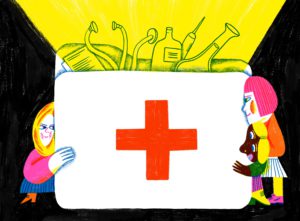
Susana Pales
Description
Rigloo Rescuer creates a safe environment for victims requiring pre-hospital emergency care, with the ability to deploy in less than a minute, avoiding problems due to exposure to unfavourable weather conditions. Unlike larger, heavier shelters, Rigloo Rescuer is a self-contained, transportable inflatable shelter designed to increase positive patient outcomes and survival.
Context
Given that 48% of the world’s population, either by birth or choice, live, work or play in rural or remote areas, emergency/pre-hospital care is, by extension, very difficult to access and, consequently, patient outcomes are often sub-optimal. A clear problem is the delay in treating victims, exacerbated by overcrowded or underdeveloped care systems. Due to population growth, treatment is delayed, causing patients to wait longer in hospitals. In addition, the associated costs, increased mortality, delays in unloading ambulances and ambulance diversions compromise response systems.
The WHO and the UN advocate non-professional partners or community response groups to support health resources. Choosing a shelter with a quick and easy-to-deploy structure that can be set up in less than a minute by a single (non-professional) responder can in return offer time to treat and provide life-saving support that positively impacts patient outcome. It is a major challenge to provide patient privacy in crowded accident sites and existing shelter options are not adequate.
First responders are faced with the dilemma of having to erect makeshift shelters or having to rely on several people to hold tarpaulins or risk having to move an injured person. Rigloo’s shelter technology can be placed over a casualty to provide a structured and comfortable space to work in. In a humanitarian and disaster situation, the first seventy-two hours are critical for treating those affected.
There is a significant lack of patient care between the time of the accident and the establishment of a semi-permanent shelter. A self-contained shelter, based on a backpack with its own inflation system, can fill this much-needed initial treatment gap. The Rescuer container is easy to handle thanks to its mosquito nets and even easier to deploy as it can be launched by helicopter or on the back of a volunteer.
Technical details & Operations
It is clear that keeping patients warm is a hallmark of good medical care. Not only are hypothermia and severe drops in patient temperatures avoided, but treatment can proceed more successfully. When a patient’s temperature drops, morbidity and mortality rates are significantly affected. If this is the patient’s condition, their care and rehabilitation will require an increase in the cost and time of treatment. A patient who comes to the emergency department on time, warm and with one or more primary injuries that have been treated correctly, will require less complex care. He may only need some imaging to confirm his primary problems and may be discharged after a short stay in hospital.
Recovery is therefore quick and uncomplicated. If this same patient suffers an environmental insult and traumatic injury, the cost of care increases and may require more extensive care (e.g. hypothermic patients are highly susceptible to cardiac dysrhythmias, decreased coagulation and increased systemic complications, among other social/psychological repercussions, along with increased associated costs and time to identify, treat and rehabilitate). This group may require a prolonged stay in a common ward or ICU and their outcome is dramatically limited as these complications worsen. The Rigloo Rescuer is a structured, inflatable shelter with a removable cover that allows it to be placed on a patient without moving the patient prior to assessment.
The design of the shelter, although complex, is simple to deploy thanks to its own manual inflation pump. It can be inflated in as little as 1 minute. Maximising retained heat will help reduce the rate of hypothermia and, in warmer climates, built-in mosquito nets can allow airflow through the shelter without allowing insects etc. to enter. The operational temperature range is between -50*C to +60*C with a fully sealable door at each end and 6 windows to allow light in. The shelter is storm proof and has been tested to over 6000mm HH for deployment in more difficult locations.
International remote area risk
“Where resources allow (vehicle, helicopter, equipment depot or transport of SAR team members), the Rescuer is an asset and a real help in terms of cost-effective, lightweight, short duration, environmentally protected treatment shelter for victims. While our experience is focused on more remote areas, we are delighted that other organisations, known for their urban/semi-urban context, who have recently been introduced to the Rescuer, will benefit from the time and experience invested in it and support our vision that this product has a definite place as a portable treatment asset for the medical and rescue community. Anything that can improve the patient (and treating professional) experience is good for us. The rapid environmental capabilities the Rescuer brings – protection from rain, wind, sun and insects – are a big plus, as is the privacy it offers.
Deployment & Impact
Rigloo Rescuer has been tested by experienced emergency responder training centres and has since been integrated into their training courses with fantastic results. They have also accumulated written testimonials from some of the UK’s leading trauma and remote care physicians demonstrating the value and necessity of a pre-hospital emergency shelter with the capabilities of the Rigloo Rescuer. Dr Mark Forrest Medical Director, The ATACC Group.
NHS Deputy Medical Director and Consultant in Anaesthesia and Critical Care, HEMS Consultant. Fire and police medical director:- River rescue, trauma and critical care partner training course held at an ATAAC training centre near Preston. “The air temperature was approximately 12/13 degrees C. The wind was blowing at 19 miles per hour from the south and the water temperature was estimated to be around 10 degrees C. It was raining for a long time and the medics reported that the shelter seemed warmer than the ambient temperature outside, and the patient, being able to take off all his clothes, there was no moisture or convective heat loss. The medical kit remained dry and the shelter allowed more hands to be available to treat the patient, due to the strength and stability of the shelter. The lowest tympanic temperature was 34.7 (first temperature taken on entering the Rigloo Rescuer).
At the end of the initial treatment and preparation for transport, the patient’s tympanic temperature was 36.5 degrees. Further samples were tested at temperatures of around 34*C to treat casualties during a disaster response exercise and, thanks to the additional SPF 30 protection provided by the shelter, casualties could be removed from the scorching heat and systematically triaged prior to transport to a hospital. The main feedback we got in this case was the functionality of the removable floor that allowed the shelter to be placed over the casualty for treatment”.
Matthew Davies FRGS – Travel Risk, Fieldwork Safety, Remote Area Duty of Care/Regulatory Law, Risk, Crisis Specialist and Lecturer, BS:8848 Committee and Drafting Committee Member, Remote Area Safety Philanthropist, Solicitor: “We have field-tested the product in remote area training courses – in suitably remote and robust environments – including in our first global extended care field course. We’re not going to give away the game to future delegates, but the course is designed for those who have done remote medical training with us to test their skills (with additional training) over an extended period, in the field. Delegates included doctors from the expeditionary, field and military sectors. The Rescuer was tested as a resource injected into the CBP course through a relevant and realistic medium. Delegates used the Rescuer to provide a mobile treatment room for a casualty for an extended period of time. The Rescuer kept the casualty and the medics treating him dry and much warmer than if they had been outside during the long, cold night. Delegates were also very appreciative of the mosquito netting, which provided a great deal of respite for medics treating the patient (and, by extension, the patient) for a long period in a mosquito-infested location. Overall, delegates were very positive about the Rescuer”.





